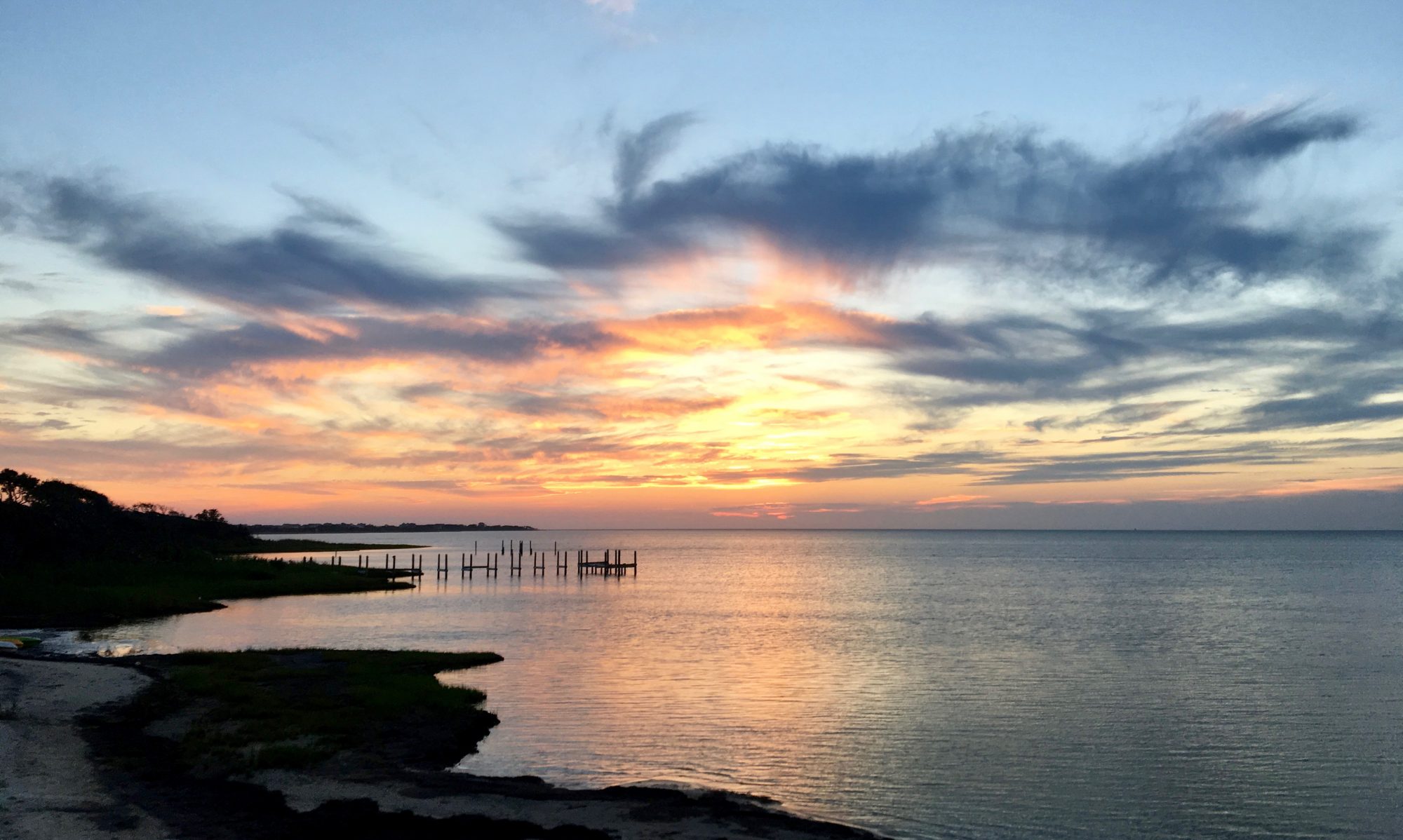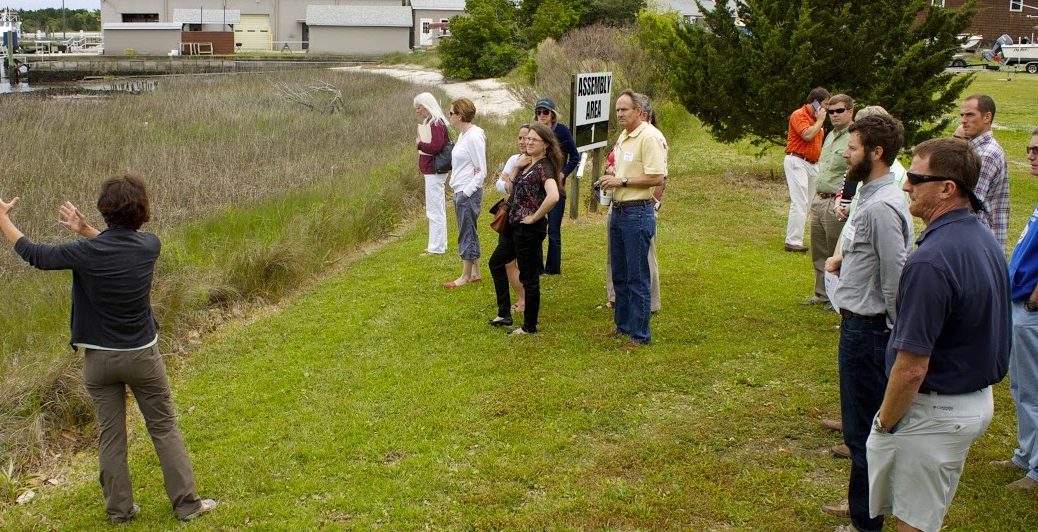By Lisa Graichen, Climate Adaptation Program Coordinator, UNH Cooperative Extension and NH Sea Grant
In North Carolina, it’s easy to get a bulkhead, and changing the regulatory framework to encourage living shorelines might be a longshot. I recently had the opportunity to talk with Whitney Jenkins, Coastal Training Program Coordinator with the North Carolina Coastal Reserve and National Estuarine Research Reserve (NCNERR) about how to combat bulkhead syndrome. NCNERR has been engaging audiences in creative, effective ways to improve awareness and understanding of shoreline management options and build support for living shoreline approaches. Their innovative approach can serve as inspiration for living shorelines efforts across the country.
A common story is that a homeowner calls up a contractor and says, “My neighbor has a bulkhead – I want a bulkhead.” They often have their mind made up going into the conversation. But they may not know about the living shoreline options available to them and the benefits those approaches have to offer. Rather than attempt to reach every individual homeowner to provide information about living shorelines, the NCNERR is focusing outreach on two key intermediary stakeholder groups: Realtors and marine contractors. This approach capitalizes on the audiences and relationships those stakeholders have in the hopes that the message will trickle down to reach more homeowners, more effectively.
Working with Realtors
The North Carolina Coastal Training Program has been conducting workshops for Realtors since 2002. Initially, workshops focused on septic systems, stormwater management and low-impact development, and barrier island development. Starting in 2011, the Program incorporated a living shorelines topic. To reach the Realtor group, the Reserve offers continuing education credits through the North Carolina Real Estate Commission. Because the Reserve is a State agency program, the Commission does not charge them to offer these workshops and credits, so they are able to offer the credits to the Realtors at no charge. Realtors are used to having to pay for credits, so these free workshops are especially well received. Being able to talk to clients about the values of marshes, oyster reefs, and other natural resources increases Realtors’ professionalism and enhances the information they’re able to provide to potential buyers.

“As a realtor, I am constantly dealing with properties on marsh and water… so this workshop will help me serve my clients better, help them make informed decisions, and provide them with possible options.” – Realtor who attended a living shorelines workshop
Engaging Marine Contractors
Then the Reserve wanted to try to reach marine contractors, but in the absence of continuing education requirements for this audience, the approach had to be different. In addition, a traditional day-long workshop approach wouldn’t meet this audience’s needs. Instead, the Reserve came up with the idea of doing a “Dinner and a Living Shoreline Movie” event. They pieced together recordings from past living shorelines workshops into a 50-minute movieand hosted three events at restaurants and auditoriums. A permit official was available at each event to talk about the permitting process and answer questions from participants. The first round of this approach was held this past winter and reached 54 people, representing 22 different construction and engineering firms, with very positive feedback from participants.

Making Other Connections
In addition to these efforts, the Reserve offers trainings on living shorelines for field staff in the state’s Coastal Program so that they can then provide information and guidance to homeowners during the permitting process. In the future, the program may also look into reaching homeowners’ associations, in another attempt to leverage resources to reach broader audiences, and also to explore opportunities to implement living shorelines on association-owned property.

Understanding Shoreline Decisions
Researchers at UNC Chapel Hill Institute of Marine Sciences have done homeowner perception surveys about shoreline decision-making factors (Smith et al., 2017). These results can inform the Reserve’s outreach and communication strategies to focus strategically on the factors that are most important to homeowners when making these decisions. This work highlights the benefits of advancing local living shorelines research – both natural science and social science – in coordination with implementing outreach and communication strategies so those efforts can be as targeted and impactful as possible.
According to Whitney, it takes “a little bit of experimenting and homeowners trusting that these natural infrastructure is going to protect their property.” I was encouraged to hear her report finding more and more contractors who are getting on board with living shorelines and are willing to experiment with these approaches in North Carolina.
Advice from Whitney
I asked Whitney what advice she would give, reflecting back on her experience working on living shorelines in North Carolina. She suggested that it’s critical to recognize and respect that the marine contractors bring a lot of first-hand knowledge about the coastal environment. She recommended incorporating waterman’s knowledge into your workshops if possible. For example, Whitney invited a local commercial fisherman to speak at a workshop about his work creating bags of oyster shells to make into living shoreline sills. At one of the “Dinner and a Living Shoreline Movie” events, one contractor shared his frustration that there is so much research going on in the area but no one had asked for his perspective. Not only do these workshops and events provide opportunities to inform an audience, but they can also serve as valuable opportunities to learn from and acknowledge the experience and expertise these audiences already bring to the table and to build new trust and relationships.
Whitney also mentioned that the state’s Coastal Program has an internal living shorelines workgroup that is very interdisciplinary. They meet quarterly to talk about everything from permitting and research to monitoring and outreach. This group provides a strategy to guide living shorelines work in the state, and also provides a variety of expertise and capacity that can be tapped into for trainings and events. The multi-pronged and creative approach North Carolina is taking to advance living shorelines and meet audiences where they are can likely be modified and replicated in other states. I know I will bring back some ideas from my conversation with Whitney to my colleagues in New Hampshire!
Another article of interest: Scyphers, Picou, and Powers, 2015
“Along densely populated coasts, the armoring of shorelines is a prevalent cause of natural habitat loss and degradation. This article explores the values and decision making of waterfront homeowners and identifies two interlinked and potentially reversible drivers of coastal degradation. We discovered that:
- misperceptions regarding the environmental impacts and cost-effectiveness of different shoreline conditions was common and may promote armoring
- many homeowners reported only altering their shorelines in response to damage caused by armoring on neighboring properties.
Collectively, these findings suggest that a single homeowner’s decision may trigger cascading degradation along a shoreline, which highlights the necessity of protecting existing large stretches of natural shoreline. However, our study also found that most homeowners were concerned with environmental impacts and preferred the aesthetics of natural landscapes, both of which could indicate nascent support and pathways for conservation initiatives along residential shorelines.”



